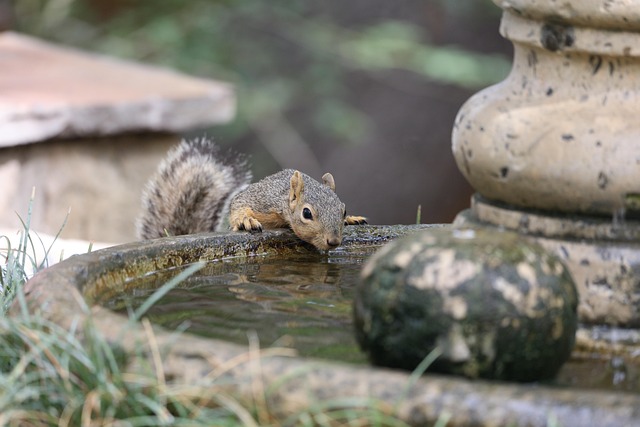Native plant landscaping is an effective way to promote ecosystem health and biodiversity by providing essential resources for local wildlife. This approach reduces maintenance, water usage, and enhances beauty while attracting pollinators, birds, and beneficial insects. By incorporating region-specific native plants in your backyard design, you create a thriving habitat that supports indigenous species and beautifies your outdoor space. Regular care and maintenance ensure a balanced ecosystem year-round.
Creating a wildlife-friendly habitat in your backyard is not only rewarding but essential for preserving biodiversity. In today’s world, where natural spaces are dwindling, even small areas can make a significant impact. This article guides you through transforming your outdoor space into a thriving ecosystem by focusing on native plant landscaping. We’ll explore the importance of these habitats, offer plant selection tips, provide landscape design strategies, and share maintenance advice to nurture a sanctuary for local wildlife.
Understanding the Importance of Wildlife-Friendly Habitats
Creating wildlife-friendly habitats in your backyard is more than just an aesthetic choice; it’s a vital contribution to the health and biodiversity of our ecosystem. By incorporating native plant landscaping, you provide essential resources for local wildlife, including food, shelter, and breeding grounds. Native plants are particularly crucial as they offer specific nutrients and habitats tailored to the needs of indigenous species, ensuring their survival and prosperity.
This approach not only helps preserve the natural balance but also enhances your outdoor space’s beauty and resilience. Unlike non-native species, which can outcompete local plants and disrupt the food chain, native plants are adapted to local conditions, requiring less maintenance and water. They attract a diverse array of pollinators, birds, butterflies, and beneficial insects, fostering a thriving microcosm right in your backyard.
Selecting Native Plants for Your Backyard
When designing a wildlife-friendly backyard, incorporating native plants is one of the most effective strategies. Native plants are those that have naturally grown in a specific region for centuries, making them well-adapted to local conditions and ecosystems. They provide essential food sources and habitats for local wildlife, including insects, birds, and small animals. By choosing native plant species tailored to your region, you create an inviting space for these creatures to forage, breed, and thrive.
Native plant landscaping offers numerous benefits beyond supporting biodiversity. These plants typically require less water and maintenance compared to non-native varieties, making them ideal for eco-conscious homeowners. Moreover, their natural resilience to local pests and diseases reduces the need for chemical interventions. The vibrant colors and unique textures of native flora also enhance the overall aesthetic appeal of your backyard, creating a harmonious outdoor sanctuary that both you and wildlife can enjoy.
Designing and Implementing Landscaping Strategies
Creating a wildlife-friendly habitat starts with thoughtful landscaping design that incorporates native plant species. Native plants are a cornerstone of this approach, offering numerous benefits like providing food and shelter for local animals, improving soil health, and reducing water usage. When planning your backyard space, opt for native shrubs, perennials, and annuals suitable for your region’s climate and soil conditions. This not only enhances biodiversity but also creates a visually appealing, low-maintenance garden that requires less artificial intervention.
Implementing these strategies involves carefully considering the placement of plants to create diverse microhabitats. Mix tall grasses and shrubs with flowering plants to provide cover and food sources for birds, butterflies, and other creatures. Create water features like small ponds or birdbaths to attract insects and amphibians. Additionally, leave some areas of your yard untouched or incorporate decaying wood to support fungi and insects that are vital to the ecosystem. By integrating these elements, you transform your backyard into a thriving, interconnected habitat that supports local wildlife.
Maintaining and Nurturing Your Wildlife Haven
Creating a wildlife-friendly habitat in your backyard is an ongoing process that requires dedication and care. Once established, maintain and nurture your haven by regularly removing any invasive plants or debris. Native plant landscaping not only supports local ecosystems but also ensures your space remains vibrant and attractive to wildlife throughout the seasons.
Regularly assess your garden’s health, monitoring for any signs of pest or disease that might disrupt the delicate balance you’ve cultivated. Keep a close eye on changes in weather patterns, as these can influence plant growth and animal behavior. Adjust watering schedules accordingly, providing necessary moisture without over-saturating the soil—a crucial aspect of maintaining a thriving wildlife sanctuary in your own backyard.
Creating a wildlife-friendly habitat in your backyard is not just an aesthetic choice; it’s a vital contribution to local ecosystems. By selecting native plants and implementing strategic landscaping, you provide essential resources for birds, butterflies, bees, and other creatures. With thoughtful maintenance, your backyard can become a thriving oasis that supports biodiversity, enhances ecosystem resilience, and offers a peaceful connection with nature right in your own space. Embrace the transformative power of native plant landscaping to nurture both wildlife and your well-being.
